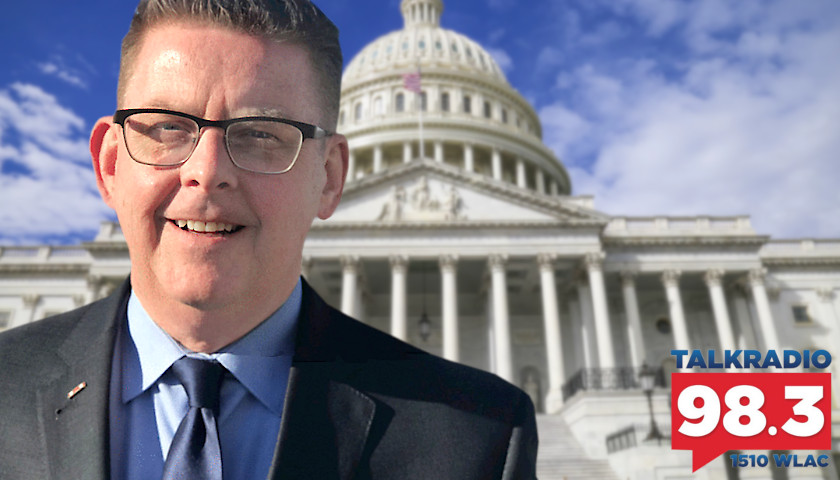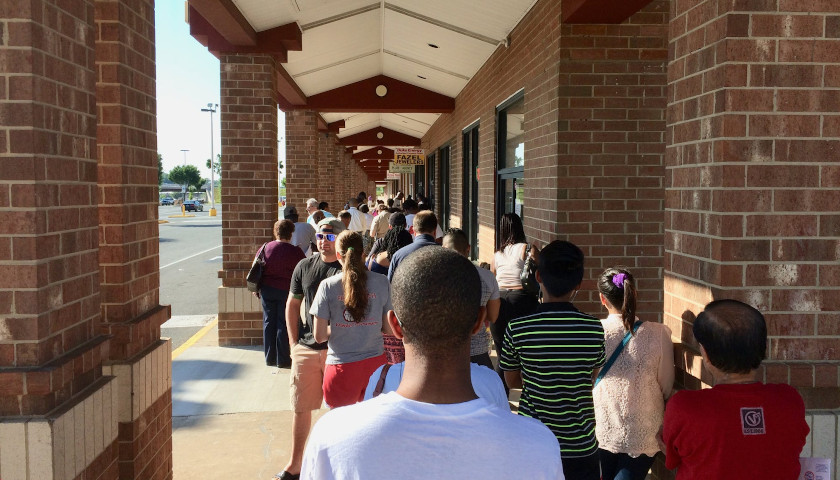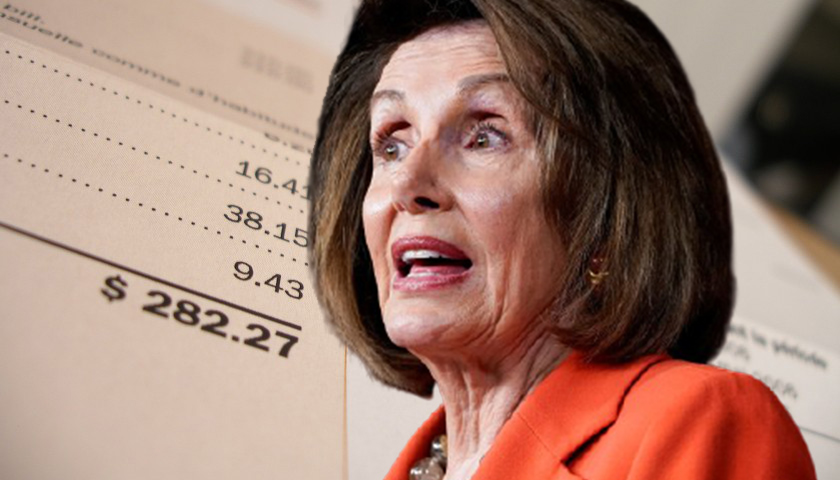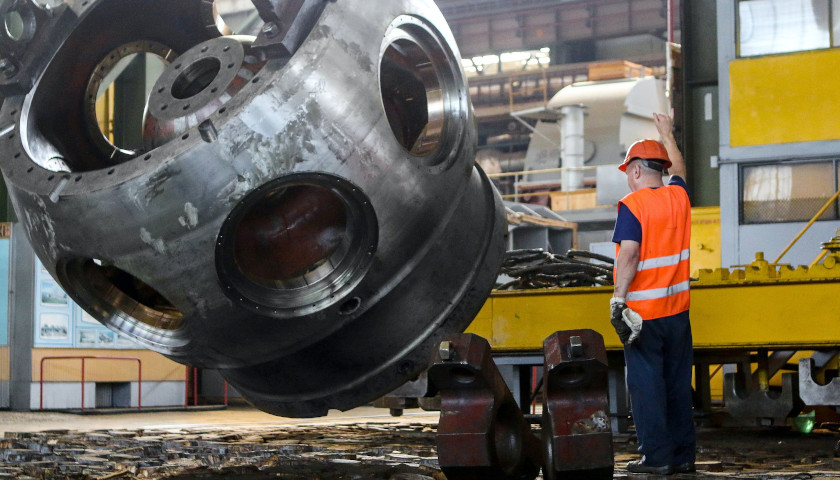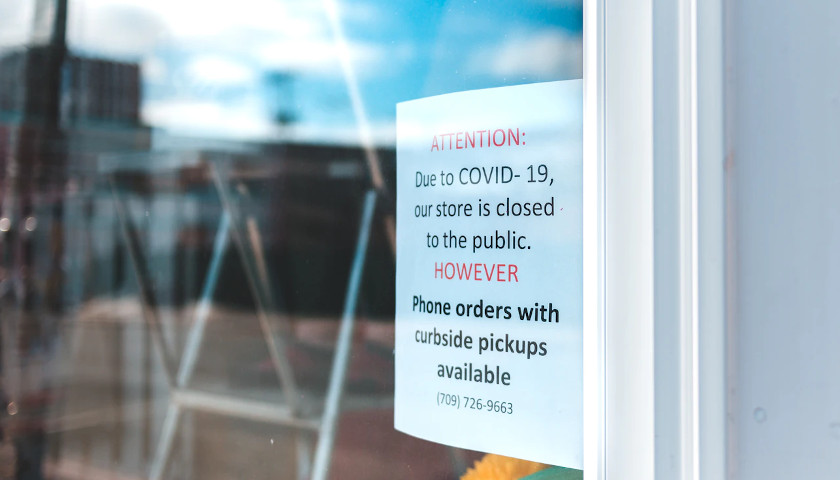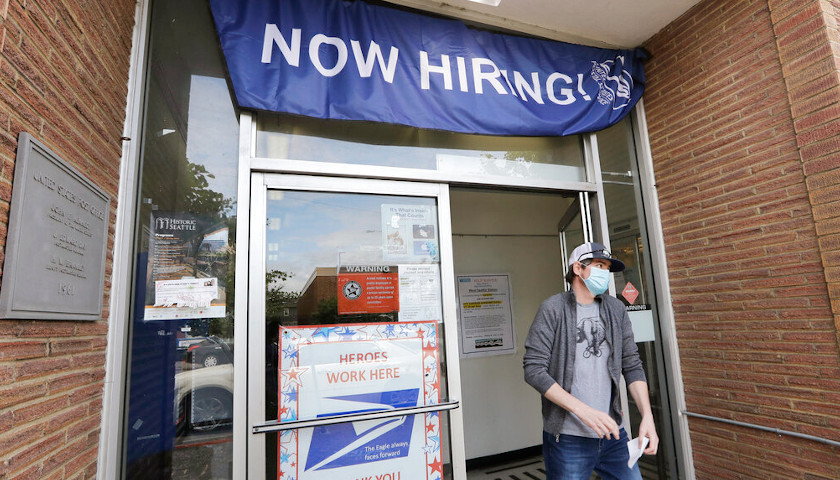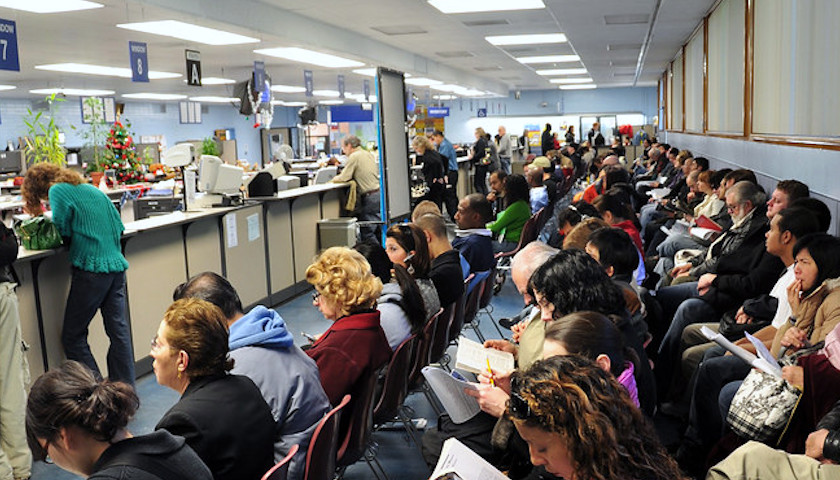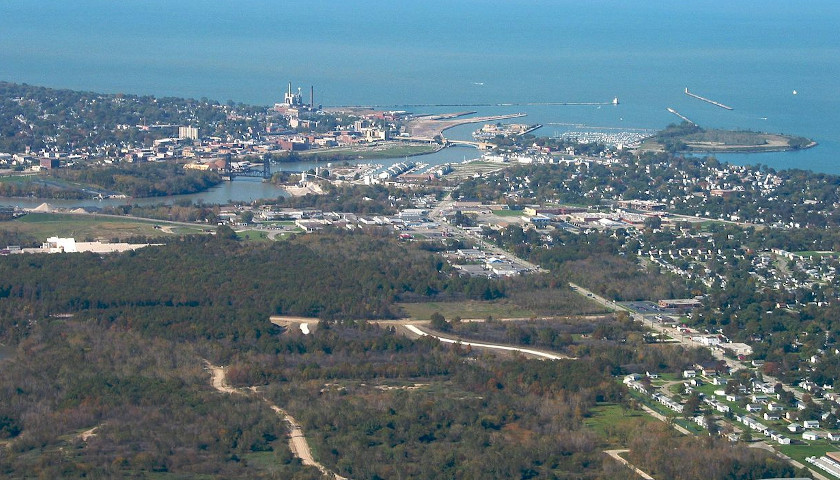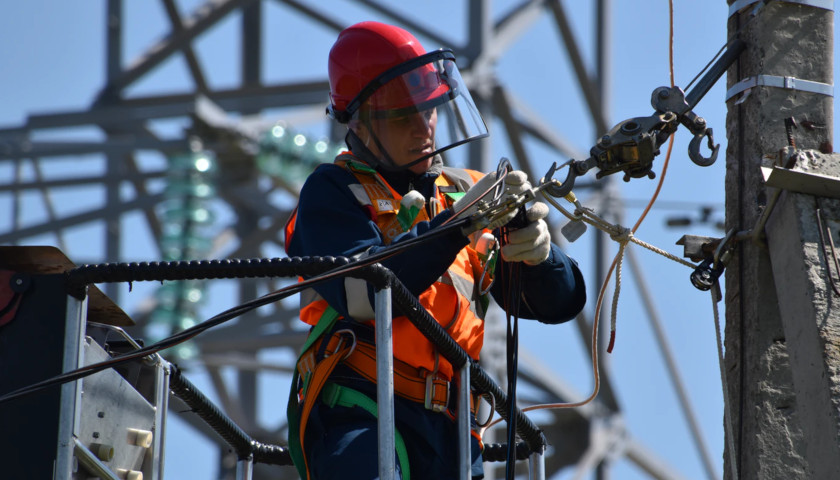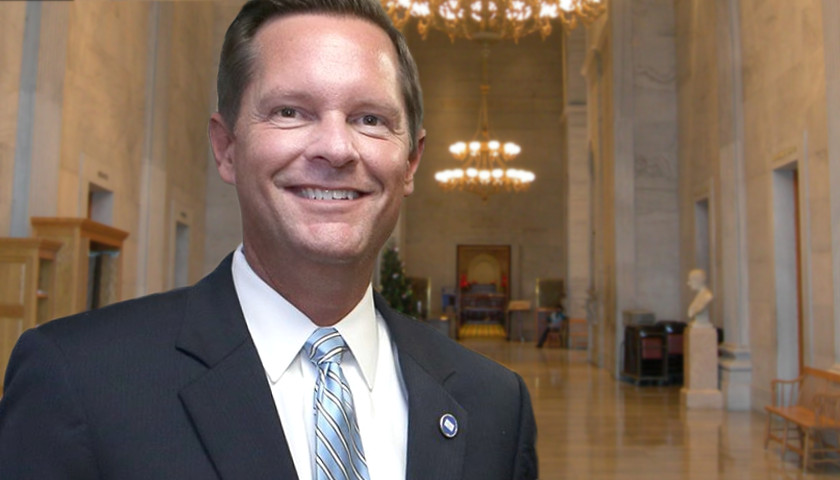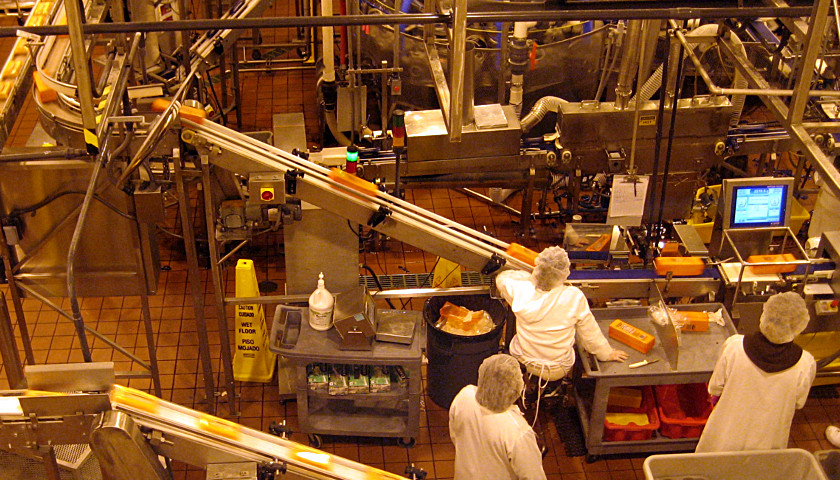Wednesday morning on the Tennessee Star Report, host Michael Patrick Leahy welcomed Washington Correspondent for the Tennessee Star Neil McCabe to the newsmakers line to weigh in on his latest piece addressing the death tax of Joe Biden.
Read the full storyTag: Jobs
U.S. Added Just 266,000 Jobs in April, Far Below Expectations
The U.S. economy reported an increase of 266,000 jobs in April and the unemployment rate rose slightly to 6.1%, according to Department of Labor data released Friday.
Total non-farm payroll employment increased by 266,000 in April, according to the Bureau of Labor Statistics (BLS) report, and the number of unemployed persons ticked up to 9.8 million. Economists projected a million Americans would be added to payrolls prior to Friday’s report, according to The Wall Street Journal.
“The pieces are really coming together for a burst in activity,” Sarah House, senior economist for Wells Fargo’s Corporate and Investment Bank, told the WSJ. “We’re expecting to see the labor market recovery shift into an even faster gear with the April jobs report.”
Read the full storyOhio Shows Worst Unemployment Recovery in Nation
Ohio had the slowest weekly unemployment claims recovery in the nation last week, based on a new report from the personal finance website WalletHub.
The report compared all 50 states and the District of Columbia over three metrics: changes in claims during the latest week compared with 2019 and 2020 and changes in claims filed from the beginning of the COVID-19 pandemic versus the previous year.
Based on the data, Ohio ranked 51st out of 51 in recovery over the latest week and 37th since the pandemic began. Ohio ranked behind Colorado, West Virginia, Mississippi and Virginia in weekly recovery.
Read the full storyAnalysis: Maximum Facts About the Minimum Wage
At 2:00 AM on Saturday, February 27, Democrats in the U.S. House of Representatives voted to pass a “COVID relief and economic support“ bill at a cost to taxpayers of $1.9 trillion. The next Saturday, Senate Democrats passed a very similar bill, and President Biden stated he will sign it. This will be the sixth “COVID relief” law and swell the tab for such legislation to a total of $5.3 trillion. The combined cost of these laws to every household in the United States will be an average of $41,036.
Read the full storyU.S. Added 49,000 Jobs in January, Unemployment Rate Fell to 6.3 Percent
The U.S. economy reported an increase of 49,000 jobs in January while the unemployment rate fell to 6.3%, according to Department of Labor data released Friday.
Total non-farm payroll employment increased by 49,000 in January, according to the Bureau of Labor Statistics report, and the number of unemployed persons fell to 10.1 million. Economists projected 50,000 Americans to be added to payrolls and the unemployment rate to increase to come in at 6.7% prior to Friday’s report, according to the WSJ.
Read the full storyUS Economy Lost 140,000 Jobs in December, Economists Expected a Modest Gain
The U.S. economy reported a decrease of 140,000 jobs in December while unemployment stayed unchanged at 6.7%, according to Department of Labor data released Friday.
Total non-farm payroll employment declined by 140,000 in November, according to the Bureau of Labor Statistics report, and the number of unemployed persons stayed stagnant at 10.7 million. The number marked the first time since April, the U.S. reported negative job growth.
Read the full storyJohn Fredericks Commentary: Coastal Virginia Offshore Wind Project Will Bring Jobs to the Commonwealth
Anybody who knows me knows I’m a jobs guy. I believe in jobs, good wages and all the positives than come from infrastructure projects. We have one about to explode in our own backyard here in Virginia – and I mean explode in a good way. It’s the multi-billion dollar economic development blockbuster known as the Coastal Virginia Offshore Wind Project. This thing has been under development for a long time…from the informational meetings years ago, the drawing boards, the public meetings, the regulatory hurdles and the construction.
Read the full storyU.S. Economy Added 638,000 Jobs in October, More Than Expected
The U.S. economy added 638,000 jobs in October, while unemployment fell to 6.9%, according to Department of Labor data released Friday.
Total non-farm payroll employment rose by 638,000 in October, according to the Bureau of Labor Statistics report, and the number of unemployed persons fell by 1.5 million to 11.1 million. The U.S. added 661,000 jobs in September while the unemployment rate dropped to 7.9%.
Read the full storyCommentary: Illegal Immigration is Costing Michiganders Jobs
This November, Michigan voters would be wise to recognize the connection between their top concern — the economy — and illegal immigration. Study after study shows that illegal immigration puts downward pressure on wages and takes away Americans’ job opportunities.
That doesn’t seem to bother Democrats. Joe Biden’s immigration plans, which Democratic senators including Gary Peters support, would put the screws to America’s working class. His agenda includes an amnesty for 11 million illegal immigrants already here. In addition, Biden wants to suspend all deportations during his first 100 days in office and relax the rules for claiming asylum.
Read the full storyCommentary: Michiganders Should Vote Like Their Jobs Depend on It
When Michiganders cast their ballots this year, they won’t just decide whether Donald Trump or Joe Biden occupies the Oval Office, or which party will control Congress.
They may well determine what Michigan’s job market looks like for years to come.
Read the full storyCommentary: Biden’s Top Five Job-Killing Policies
Under a Joe Biden presidency, millions of American workers would lose their jobs, families would struggle to pay higher taxes, and many would be forced into unions against their will. At a time when millions of Americans are already struggling due to Covid-19 economic shutdowns, Biden’s job-killing policies would be a disaster.
Read the full storyCommentary: Economic Bounce Back Continues with 14.1 Million More Jobs Recovered Since April
Another 275,000 jobs were added to the U.S. economy in the month of September, according to the Bureau of Labor Statistics’ (BLS) household survey, and 661,000 in the establishment survey, adding to the miraculous economic recovery that has taken place since COVID-19 lockdowns this spring as now states and businesses continue reopening at a rapid clip.
Read the full story661,000 Jobs Added in September, Less Than Expected
The U.S. economy added 661,000 jobs in September, while unemployment fell to 7.9%, according to Department of Labor data released Friday.
Total non-farm payroll employment rose by 661,000 in September, according to the Bureau of Labor Statistics report, and the number of unemployed persons fell by 1 million to 12.6 million.
Read the full storyCommentary: Pelosi Holds Millions of Small Businesses Hostage While Working Families Struggle
At the height of the COVID-19 pandemic, when a lot less was known about the virus and how to counter it, and while the nation was still ramping up production of testing and hospital resources including ventilators needed, 25 million jobs were lost across the country, according to Bureau of Labor Statistics data.
Since labor markets bottomed in April, 13.8 million jobs have been recovered, as states have begun steadily reopening in the months since.
Read the full storyNew Unemployment Claims Decrease to 860,000, Beating Predictions
The number of Americans filing new unemployment claims decreased to 860,000 last week as the economy continues to suffer the effects of the ongoing coronavirus pandemic, according to the Department of Labor.
The Department of Labor figure released Thursday represented an decrease of new jobless claims compared to the week ending on Sept. 5, in which there were 884,000 new jobless claims reported.
Read the full storyUS Economy Added 1.4 Million Jobs in August, Unemployment at 8.4 Percent
The U.S. economy added 1.4 million jobs in August, while unemployment fell to 8.4%, according to Department of Labor data released Friday.
Total non-farm payroll employment rose by 1.4 million in August, according to the Bureau of Labor Statistics report, and the number of unemployed persons fell by 2.8 million to 13.6 million. The unemployment rate fell below 10% for the first time since April when the rate reached 14.7%.
Read the full storyAmazon to Add Thousands of Tech, Corporate Jobs in Six American Cities
Amazon plans to create 3,500 new tech and corporate jobs in six cities nationwide, the company announced Tuesday.
Most of the company’s new hires will be located in Amazon’s New York office with the rest being added in Dallas, Detroit, Denver, Phoenix and San Diego, according to a press release. Amazon also announced plans to expand the six offices to accommodate the new hires.
Read the full storyCommentary: Will the Virus Ever Allow the U.S. Economy to Fully Reopen Again?
The U.S. economy contracted a record-setting, inflation-adjusted, annualized 32.9 percent in the second quarter of 2020 according to the latest data from the Bureau of Economic Analysis as tens of millions of Americans waited out the Chinese coronavirus in their homes, not venturing out much except for work and needed supplies.
The second quarter comprises of April, May and June, when in Bureau of Labor Statistics’ household survey 25 million jobs were lost by April and then 8.8 million came back in May and June as states slowly began reopening.
Read the full storyHiring Soared in May as Mass Layoffs Eased
The job market took a big step toward healing in May, though plenty of damage remains, as a record level of hiring followed record layoffs in March and April.
The Labor Department reported Tuesday that the number of available jobs rose sharply as well, but remained far below pre-pandemic levels.
Read the full storyMichigan Had 17 of 25 Counties with Highest Unemployment Nationally in April
Michigan was home to 17 of the 25 counties with the highest unemployment numbers in the nation in April.
According to a database from Lansing State Journal, Cheboygan County led the nation in unemployment with a 41.2 percent unemployment rate. Second in the nation was Mackinac County at 38.1 percent.
Read the full story3.3 Million File Unemployment Claims in U.S. – a Record Number
Nearly 3.3 million Americans filed unemployment claims last week, a record number as businesses were forced to shut down to help slow the spread of the novel coronavirus.
The U.S. Department of Labor reported Thursday that 3.28 million claims were filed in the week that ended March 21. That marked an increase of more than 3 million claims over the week prior, when 282,000 claims were filed.
The previous high in a single week, according to the department, was in October 1982, when about 695,000 claims were filed. The nearly 3.3 million claims filed last week is nearly five times the prior record.
Read the full story2019 Was the Slowest Year for New Jobs in Ohio in a Decade, Economist Says
An economic expert says Ohio’s latest unemployment data show 2019 was the slowest year for new jobs in a decade — and the state lagged behind the nation in creating new jobs.
Read the full storyAnnual Survey Shows Minnesota Manufacturers Anticipate Strong Economy in 2020
An annual survey of Minnesota’s manufacturing sector shows respondents anticipate stable or improved economic conditions in 2020.
Read the full storyCommentary: This Ohio Town Is Seeing Manufacturing Jobs Come Back
Thirty miles west of Cleveland along the Lake Erie shoreline sits a town named Lorain, Ohio. Famous for being the birthplace of Toni Morrison, Lorain was once a bustling steel town that drew people from all over the country for manufacturing work. Even the high school football team was named “The Steelmen.” But today, like many Rust Belt towns, Lorain shows signs of decay: ramshackle houses, vacant buildings covered in graffiti, and abandoned plants and factories — lots of them.
Read the full storyCommentary: Good Economic News Missing From the Mainstream Media Again
You didn’t see it on the front page of one of the establishment newspapers or in the lead segment on establishment TV, but Reuters reported the number of Americans filing applications for unemployment benefits unexpectedly fell last week, hitting their lowest level in seven months, indicating the labor market remains solid.
Read the full storyCommentary: The Good Economic News No One Heard About
A few weeks ago, the Census Bureau released the 2018 Income and Poverty in the United States report, but you probably didn’t see anything about it because it received scant attention in the establishment media because it reported such positive results mostly attributable to President Trump’s economic policies. Instead, what little media attention that the report received focused on a meaningless measure of income “inequality.”
Read the full storyOctober Jobs Report: 128,000 Jobs Added, Unemployment at 3.6 Percent
The U.S. economy added 128,000 jobs in October, while the unemployment rate rose to 3.6%, according to Department of Labor data released Friday.
Read the full storySeptember Jobs Report: 136,000 Jobs Added, Unemployment Declines to 3.5 Percent
The U.S. economy added 136,000 jobs in September, while the unemployment rate declined to 3.5%, according to the Department of Labor data released Friday.
Read the full storyCommentary: The August Jobs Report Is Not ‘Mixed’ It’s Yuuge
The anti-Trump talking-down-the-economy crowd has America already in a recession, with POLITICO’s Morning Money leading its Thursday morning news with, “…manufacturing in recession and capital expenditures dropping, the strong consumer is the final leg holding up the U.S. economy. But the length of the workweek dipped in July, often a leading signal that employers are cutting back. A sharp slowdown in job creation could follow.”
Read the full storyAugust Jobs Report: 130,000 Jobs Added, Unemployment Remains at 3.7 Percent
The U.S. economy added 130,000 jobs in August, while the unemployment rate remained at 3.7%, according to Department of Labor data released Friday.
Read the full storyBlack Unemployment Hits Record Low, Spurred By Uptick In Employment for Black Women
Black unemployment hit a record low in August, spurred by an uptick in employment for black women.
Read the full storyFAKE NEWS: Drudge Report Touts MarketWatch Article of Half-Million Jobs Lost When 2.2 Million Jobs Were Created
You might have noticed some alarmist reporting from Marketwatch and the Drudge Report implying the economy lost 500,000 jobs last year.
Read the full storyJuly Jobs Report: 164,000 Jobs Added, Unemployment Remains at 3.7 Percent
The U.S. economy added 164,000 jobs in July, while the unemployment rate remained at 3.7%, according to Department of Labor data released Friday.
Read the full storyCameron Sexton Radio Spots Promote Republican Legislative Accomplishments
State Representative Cameron Sexton (R-Crossville) is promoting the legislative accomplishments of the Republican Administration and legislative supermajorities with a new pair of radio ads. Many of the successful legislative items, from tax cuts to school safety to job creation were lost in the shuffle when scandals involving House Speaker Glen Casada and his top staffers captivated the media as the Session ended. Sexton ran similar spots intended to advance the agenda of the Republican supermajority in the House earlier in the year. As Caucus Chair he has said that part of his role is policy, not just politics, and the ads during Session and in advance of a Special Session in August are an important way to fulfill that role. Sexton is seeking the nomination for House Speaker in a Republican Caucus meeting scheduled for later this week. The winner of that election, which requires at least 37 votes in the 73 Member Caucus, is expected to succeed House Speaker Glen Casada following his resignation on August 2. The full House will vote on a new Speaker on August 23 during the Special Session called by Governor Bill Lee. Tennessee Star Political Editor Steve Gill says the ads are…
Read the full storyJune Jobs Report: 224,000 Jobs Added, Unemployment At 3.7 Percent
by Mary Margaret Olohan The U.S. economy added 224,000 jobs in June, while the unemployment rate slightly increased to 3.7 percent, according to Department of Labor data released Friday. 224,000 jobs were added in June, according to the Bureau of Labor Statistics report, about double the number economists predicted. The number of adults working or looking for work remained steady at 6 million, according to the Labor Department. The Labor Department reports that employment growth has averaged 172,000 per month thus far this year, compared to 223,000 a month in 2018. Economists predicted the economy would add 165,000 jobs and the unemployment rate would remain at about 3.6 percent, according to The Wall Street Journal. The June figures come on the heels of May’s job report that revealed unemployment steadily showing the lowest numbers in 50 years. The U.S. economy added 75,000 jobs in May, while the unemployment rate remained at 3.6 percent. Economists had predicted 180,000 jobs would be added and that wage growth would rise to about 3.2 percent. Job growth has come back strong after February when just 33,000 jobs were added. The unemployment rate has held steady between 4 percent and 3.7 percent for more…
Read the full storyMay Jobs Report: 75,000 Jobs Added, Unemployment Remains at 3.6 Percent
by Mary Margaret Olohan The U.S. economy added 75,000 jobs in May, while the unemployment rate remained at 3.6 percent, according to Department of Labor data released Friday. Economists predicted 180,000 jobs would be added and that wage growth would rise to about 3.2%, according to The Wall Street Journal. Jobs numbers for April were 263,000 jobs added, according to the Bureau of Labor Statistics report. After a decline in April, the number of persons unemployed for less than five weeks increased by 243,000 up to 2.1 million. The May jobs report comes on the heels of April’s job report that showed the lowest unemployment numbers in 50 years. The U.S. economy added 263,000 jobs in April, while the unemployment rate fell to 3.6 percent. Economists had predicted only 190,000 jobs added and a continued unemployment rate of 3.8 percent. Jobs growth has come back strong after February when just 33,000 jobs were added. The unemployment rate has held steady between 4 percent and 3.7 percent for more than a year before the April jobs report showed it drop to 3.6 percent. Prior to April’s report, the consistent unemployment rate suggested that workers are jumping back into the workforce…
Read the full storyOhio’s Unemployment Rate Drops to 4.4 Percent from February to March
Ohio’s state unemployment rate is at an 18 year low even after General Motors closing down its Lordstown factory. The Buckeye state’s unemployment dropped from 4.6 percent in February to 4.4 percent in March. The last time Ohio’s unemployment reached 4.4 percent back was in August of 2001. Despite this decrease in unemployment, Ohio is still behind the national average of 3.8 percent. The 0.2 percent shift from was partly the result of a reduction of 7,000 citizens unemployed, bringing the state unemployment from 265,000 to 258,000 between February and March. This growth is slightly contingent on the state’s strong agricultural and seasonal workforce. Andrew J. Kidd, PhD and economist with The Buckeye Institute, stated in on Friday that “spring has brought a rebirth to job growth in Ohio with 6,200 new private sector jobs, a falling unemployment rate of 4.4 percent, and a growing labor force participation rate of 62.7 percent. All these are positive signs for Ohio’s economy.” With a labor force participation rate of 62.7 percent, Ohio is quickly catching up to the national average of 63 percent. The closing of the General Motors Lordstown factory did some damage, contributing to a drop of 2,400 in manufacturing,…
Read the full storyHiring Rebounds as US Employers Add a Solid 196,000 Jobs
Hiring in the United States rebounded in March as U.S. employers added a solid 196,000 jobs, up sharply from February’s scant gain and evidence that many businesses still want to hire despite signs that the economy is slowing. The unemployment rate remained at 3.8 percent, near the lowest level in almost 50 years, the Labor Department reported Friday. Wage growth slowed a bit in March, with average hourly pay increasing 3.2 percent from a year earlier. That was down from February’s year-over-year gain of 3.4 percent, which was the best in a decade. The employment figures reported Friday by the government suggest that February’s anemic job growth — revised to 33,000, from an initial 20,000 — was merely a temporary blip and that businesses are confident the economy remains on a firm footing. Even with the current expansion nearly 10 years old, the U.S. economy is demonstrating its resilience. At the same time, the economy is facing several challenges, from cautious consumers to slower growth in business investment to a U.S.-China trade war that is contributing to a weakening global economy. Stock futures rallied after Friday’s jobs data was released at 8:30 a.m. and bond prices rose as well, with…
Read the full storyUnemployment Jumps, Minnesota Loses 8,800 Jobs During Walz’s First Full Month
Minnesota’s Department of Employment and Economic Development, or DEED, released its monthly jobs report Thursday, and the results weren’t good for Gov. Tim Walz’s first full month in office. According to the report, Minnesota lost 8,800 seasonally adjusted jobs in February, and the unemployment rate climbed from 3 percent to 3.1 percent, compared to a national unemployment rate of 3.8 percent. February 2019 saw 1,364 fewer jobs than February 2018 and was the first month of annual job decline since July 2010. Of the 11 major industries, seven saw job declines, with construction losing the most at 3,800 fewer jobs. “The most significant decline this month was in construction, losing 3,800 jobs—not shocking given the brutal February we had,” DEED Commissioner Steve Grove said in a news release. “Along with that, we know that Minnesota faces dwindling labor force growth—we can’t have job gains without people to fill the positions.” The trade, transportation, and utilities industry dropped 3,000 jobs, while education and health care lost 2,300 jobs, and manufacturing lost 1,600. The largest gain was recorded in the professional and business services industry with 1,300 new jobs, followed by 1,000 new jobs in financial activities, and 400 new jobs in…
Read the full storyCommentary: Government Does Not Create Jobs
by Rick Manning Government does not create jobs, the private sector creates jobs. This is the basic rule that gets obscured in the political back and forth over the economy. And truthfully, it is very tempting to forget when you work for the government focused upon trying to increase opportunities for Americans in a changing workforce. What government policies can do is create or undermine the conditions upon which the private sector operates in the hopes that the overall net of the millions of decisions made each month on whether to increase or reduce the payroll will be a net plus, but apart from directly hiring new employees, government has very little immediate direct impact on the unemployment numbers. This is why President Obama’s shovel ready jobs stimulus package was such an abysmal failure. The presumption that if you pump almost a trillion dollars into the economy you are going to jump-start the workforce simply did not work because government, particularly the federal government, is anguishingly slow in action. From the identification of target sectors and the grant application preparation to the evaluation of thousands of requests to the awarding of the money by the government takes months, if…
Read the full storyUS Adds Just 20K Jobs; Unemployment Dips
Hiring tumbled in February, with U.S. employers adding just 20,000 jobs, the smallest monthly gain in nearly a year and a half. The slowdown in hiring, though, might have been depressed by harsh winter weather and the partial shutdown of the government. Last month’s weak gain came after employers had added a blockbuster 311,000 jobs in January, the most in nearly a year. Over the past three months, job growth has averaged a solid 186,000, enough to lower the unemployment rate over time. And despite the tepid pace of hiring in February, the government’s monthly jobs report Friday included some positive signs: Average hourly pay last month rose 3.4 percent from a year earlier _ the sharpest year-over-year increase in a decade. The unemployment rate also fell to 3.8 percent, near the lowest level in five decades, from 4 percent in January. Unseasonably cold weather, which affects such industries as construction and restaurants, afflicted some areas of the country in February. And the 35-day government shutdown that ended in late January likely affected the calculation of job growth. Still, the hiring pullback comes amid signs that growth is slowing because of a weaker global economy, a trade war between the…
Read the full storyReport: Ohio Job Growth Strong in 2018
Friday, Ohio’s private economic development corporation, JobsOhio, released their annual report for 2018. The report assessed current projects, jobs created, jobs maintained, and lastly, capital investments. By these metrics, 2018 appeared to be a strong year for Ohio. However, there are qualifiers to their findings. Overall, by JobsOhio assessment, the organization was involved in 266 projects across Ohio. This is actually a small decrease from previous years. In 2016, the organization was involved in 284 projects and 272 in 2017. However, the payroll and jobs created from these projects are significantly higher. The total payroll for 2018 $1.3 Billion with 27,071 new jobs created. Both of these figures represent significant jumps. While the report does not list the number of jobs lost or why the number of projects decreased, it does list the number of jobs retained. In total, 69,905 were retained in 2018, for a total payroll value of $4.2 Billion. Capital investment remained constant with last year at $9.6 Billion. It should be noted that the job numbers for 2018 reflect future jobs and spending commitments which means that, when the projects are launched, the actual numbers could vary significantly. According to the report, the majority of these new jobs were made in…
Read the full storySteve Cortes Commentary: The U.S. Economy Is Proving Critics Wrong Yet Again
by Steve Cortes The booming U.S. economy is proving the Democrats wrong yet again — liberals keep predicting a recession, but businesses just keep on hiring. According to the recently published data from the Department of Labor, nonfarm payrolls surged by 304,000 jobs in January, nearly doubling the 165,000 jobs that so-called experts predicted in light of the government shutdown. “The job market weathered the government shutdown well. Despite the severe disruptions, businesses continued to add aggressively to their payrolls,” Moody Analytics chief economist Mark Zandisaid Wednesday in anticipation of the report. “As long as businesses hire strongly the economic expansion will continue on.” Although the unemployment rate rose slightly — from 3.9 percent to 4.0 percent — that was partly because the labor force participation rate also increased to 63.2 percent, its highest level since President Trump took office. The strong private sector growth in January directly contradicted the doomsday forecasts of Democrats and the mainstream media, who spent weeks arguing that the government shutdown would negatively impact the economy. “It’s Christmas Eve and President Trump is plunging the country into chaos,” then-House Speaker nominee Nancy Pelosi and Senate minority leader Chuck Schumer said in a joint statement last December. Their deliberate fear mongering…
Read the full storyOhio Jobs Report: A Strong Year Ends on a Dismal Note
While 2018 was, overall, steady for job growth, the year ended on a sour note for the Buckeye State. The Ohio jobs report for December 2018 has been released and it appears to have been a disappointing month. While unemployment remained at an unchanged 4.6 percent from November to December, the number of unemployed increased by over 2,000. This is in contrast to an overall gain of more than 16,000 jobs in 2018. Some business sectors were hit harder than others. The private sector lost 500 jobs and, surprisingly, 4,300 jobs were lust in the retail market during the Christmas season. While the aggregate numbers still represent an improvement, they’re frustrating for many as the U.S. unemployment rate was 3.9 percent during that same time period. The disappointing numbers also pointed to a greater issue. Andrew J. Kidd, Ph.D., an economist with The Buckeye Institute’s Economic Research Center noted: Of continuing concern is Ohio’s labor force. The unemployment rate only fell slightly this year from 4.9 percent to 4.6 percent, while the labor force actually shrunk. This comes after United Van Lines released their annual report, which found more Ohioans had moved out of the state than moved into the state. If…
Read the full storyAs US Economy Swells, Ohio Gets Left Behind
2018 was one of the best economic years for America in decades. The coup de grâce came in December with a jobs report that shattered the most generous expectations by more than double. 312,000 new jobs were added to the US economy. While unemployment rose slightly, this was primarily due to more people getting back into the job market after giving up hope of finding work. In total, more than 2.6 million jobs were added in 2018; the fastest job growth in decades. So how did Ohio fare? Not great. Ohio undoubtedly had some noteworthy achievements. 2018 was Ohio’s ninth consecutive year of record-breaking new business filings with 125,000 new businesses created. In July, Ohio’s jobs growth pace actually exceeded the national pace. Overall, Ohio added jobs and employment grew. Sadly, in some of the most key indicators, Ohio continued to lag behind the nation. In November, while the national unemployment rate rested at 3.7% (its lowest rate in 2018), Ohio’s unemployment rate was 4.6%. Ohio’s best month for unemployment (4.3%) didn’t even beat the nation’s worst month (4.1%). From January to November of 2018, Ohio’s total number of unemployed went from 271,269 to 263,197, a net employment of only 8,072 jobs. While some…
Read the full storyOhio Proves Resilient as the Partial Government Shutdown Marks Its Second Week
With no end in sight to the partial-government shutdown, federal workers nationwide are adjusting to the possibility of an extended shutdown. While many areas of the country are heavily impacted, Ohio is poised to weather this storm. In a new report published Thursday, Ohio was revealed to be one of the states least affected by the government shutdown. Of all 50 states and the District of Columbia, The District was the most negatively affected with Minnesota as the least. Ohio came in at 42nd. The report was executed by WalletHub, a financial services company based in Washington DC. The rankings were the result of combining measurements for; Share of Federal Jobs Share of Federal Contract Dollars Per Capita Percentage of Families Recieving SNAP Real Estate as Percentage of Gross State Product Access to National Parks The report also found states which voted Democrat in 2016 were slightly more affected than states that voted Republican. According to the Labor Department numbers, as of June 2017, Ohio has 78,575 federal employees. While many of these Ohio residents have been affected by the government shutdown, almost half of these employees are military personnel, Department of Defense employees, of Veterans Affairs employees. This partial shutdown…
Read the full storyThe Most People in Nearly 20 Years Quit Their Jobs for Better Ones in 2018
by Tim Pearce Roughly 2.4 percent of the Americans in the workforce quit their jobs in the past year, the fastest rate since 2001, according to the Bureau of Labor Statistics (BLS). The BLS’s most recent version of the Job Openings and Labor Turnover Survey (JOLTS) found that an average of 3.5 million Americans quit their jobs every month in 2018. The data suggest that more people are leaving jobs to search for or take opportunities elsewhere for better pay or more prestigious positions. “For any type of employment search, you won’t find a better time than right now,” Thomas Moran, CEO of the staffing agency Addison Group, told CNBC Make It. Unemployment has remained at historically low levels since September, the sign of a tight labor market that should drive wages and benefits up as employers compete to attract and retain workers. “For many, [quitting] is a smart move, as there’s a clear advantage to increasing your earning potential by switching jobs,” Glassdoor chief economist Andrew Chamberlain told CNBC. So far, wage growth has remained below economists’ expectations, though wages have picked up in the past year. Wages hit 3.1 percent annual growth in November, the first time…
Read the full storyCommentary: Illegal Immigration Hurts Black Americans Most
by Spencer P. Morrison In the 19th century, savvy American saloon-owners offered free lunches to attract noontime patrons. Inevitably, the diners would get thirsty and buy expensive drinks—thus was born the expression, “there’s no such thing as a free lunch.” Despite its humble origins, the phrase captures a deep and omnipresent truth: everything has a price, an opportunity cost, a trade-off. This is as true of lunches as it is of America’s immigration policy. Although The Economist‘s propaganda-artists claim otherwise, mass immigration does not enrich all Americans. There are obvious winners and losers. The winners are wealthy Americans and the immigrants themselves; the losers are everyone else, especially the working class, Millennials, and black Americans. Black Americans are an interesting demographic. On the one hand, black Americans vote for Democrats by obsequious margins—often in excess of 90 percent. And yet black Americans are hurt most by the Democrats’ immigration policy. In short: mass immigration, legal and illegal, disproportionately hurts black Americans because they are the ones most likely to compete directly with immigrants for work. At the Hot Gates A great mob of men marches towards our southern border—thousands strong and growing daily. All eyes are on them. But…
Read the full story‘Don’t Screw Us Over,’ Ohio Workers Warn Candidates
by Ramon Taylor Brandy Corwin likes that she can now wear makeup and nice clothes to work. That is because she is no longer working on the assembly line at the General Motors plant in Fort Wayne, Indiana. “I was laid off multiple times, and having a family, you can’t rely on that,” she said. For the past five months, Corwin, 28, has been working at Credit Adjustments, Inc. (CAI), a debt collection agency headquartered in her hometown of Defiance, Ohio, an hour outside the city of Toledo. Corwin was a third-generation manufacturing worker and thought the assembly line was her fate. But now, she no longer has to work overtime and weekends to make ends meet. “I finally have a good work-to-home life balance,” she said, “and I didn’t have that before.” Her two children “love seeing me come home dressed up,” Corwin said. “My son, he compliments me all the time: Wow, Mommy, your hair looks really nice,’ or ‘Wow, Mom, I love your dress,’ because I’m not walking home in dirty jeans and steel-toe boots.” CAI opened its first area call center in downtown Toledo last January, providing 60 new job opportunities, with the goal of adding…
Read the full storyJobless Welfare Claims Near a Five-Decade Low
by Tim Pearce The number of Americans claiming unemployment insurance fell unexpectedly in late September after economists anticipated destruction from Hurricane Florence to hold claim numbers steady. The number of unemployment filings edged back toward the lowest rate in nearly five decades. The four-week moving average fell to the lowest rate since October 1973, according to data released by the Department of Labor Thursday. Roughly 207,000 people filed for initial jobless claims. The amount fell 8,000 from the week prior and outpaced economists’ expectations that the number would continue to sit around 215,000, signaling a stronger labor market that can absorb new workers quickly, according to The Wall Street Journal. “In the week ending September 29, the advance figure for seasonally adjusted initial claims was 207,000, a decrease of 8,000 from the previous week’s revised level,” according to the Labor Department. North Carolina, South Carolina and Kentucky posted the largest unemployment numbers, likely due to Hurricane Florence. Many residents in the area might have not filed for benefits yet, which could lead to higher unemployment numbers in those states in the short-term. The unemployment rate for August measured at 3.9 percent. Economists predict the rate will fall slightly to 3.8 percent in September. September’s initial jobs numbers will be…
Read the full story
